Women are presenting to emergency rooms after taking abortion pills, and the pro-abortion media seems perfectly willing to paint it as no big deal.
Women are suffering due to a lack of proper medical oversight and continuity of care, because Big Abortion does not want to take responsibility and spend the extra time and money to properly care for their clients. Rather than hold the profiteers of abortion responsible, a complicit media grants them cover, claiming women at emergency rooms are there to merely “ask questions” or because a follow-up pregnancy test is not “accurate.”
If this sounds ludicrous, that is because it is.
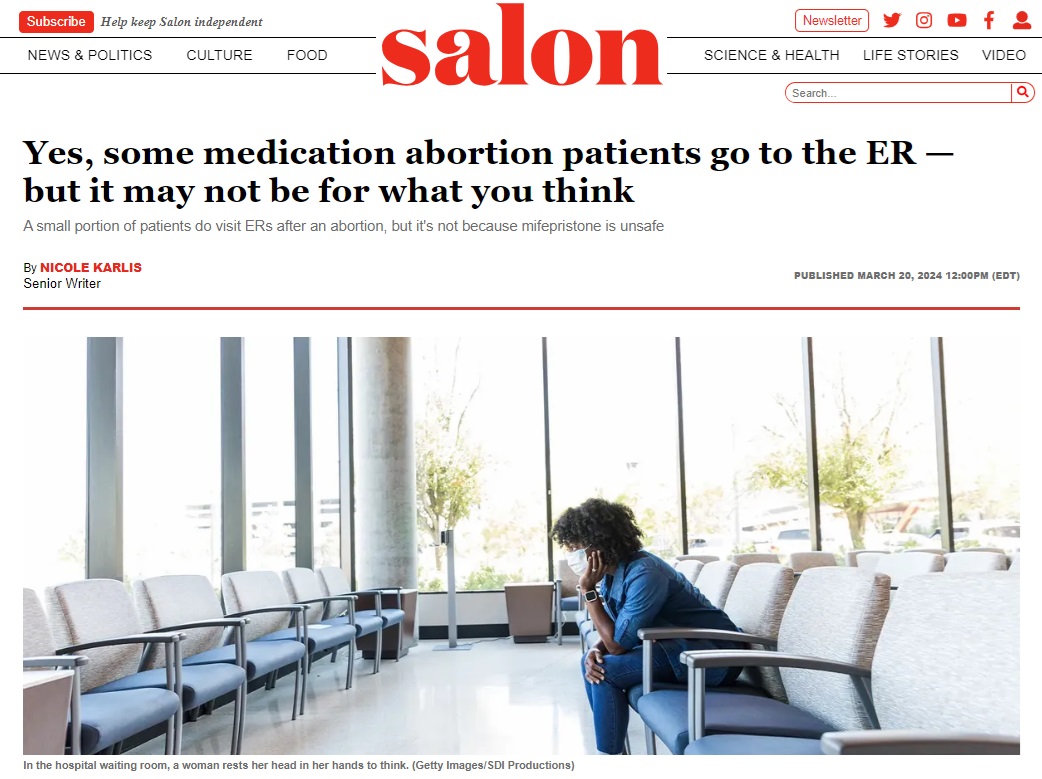
Salon article admits abortion pill profiteers are sending women to emergency rooms
As the plaintiffs in a lawsuit heard this week before the U.S. Supreme Court (Alliance for Hippocratic Medicine (AHM) v. Food and Drug Administration) argued, the FDA’s reckless decision to expand abortion pill access by removing the in-person requirement for women to obtain the drug and allow mail order and pharmacy dispensing of the deadly pills is creating an environment whereby potentially tens of thousands of women are presenting to emergency rooms after taking the abortion pill regimen.
The lawsuit is asking the Supreme Court to reinstate “essential safeguards” put in place on the abortion pill in a safety system called REMS by the FDA prior to 2016.
Setting the Stage: Salon’s Big Abortion Spokespersons
Writers of a Salon piece, entitled, “Yes, some medication abortion patients go to the ER — but it may not be for what you think,” drew their ridiculous conclusions from spokespersons tied to Big Abortion, namely Ushma Upadhyay and Dr. Kara Cadwallader.
Ushma Upadhyay was introduced by Salon as “a public health scientist at Advancing New Standards in Reproductive Health (ANSIRH), based at the University of California-San Francisco.”
But Salon gave no background about ANSIRH, which was founded by abortionist Felicia H. Stewart and is funded by the Packard Foundation, which provided early financial assistance to the abortion pill’s U.S. manufacturer, Danco. Packard also invests millions in the generic version of the drug made by GenBioPro, Inc.
Upadhyay is a professor at the University of California San Francisco (UCSF) and has argued that the FDA should “remove as many barriers as possible” on the abortion pill. She oversaw “The California Home Abortion by Telehealth (CHAT) Study” which took place at ANSIRH, and was an early advocate of the “no test/no touch” protocol for the abortion pill, which eliminated important preliminary labs, testing, and ultrasounds — potentially placing women in harm’s way.
The Buffett Foundation, another early abortion pill investor, invests in Upadhyay’s employer, the University of California (UC) system, and is a collaborator in abortion pill clinical trials. In past years, Buffett gave $78 million to UC — and according to the New York Times, Buffett is the primary financier of the Bixby Center’s Ryan Residency Program at UCSF, where abortionists are trained.
Dr. Kara Cadwallader is described by Salon as “a family medicine physician in Idaho” but what Salon conveniently left out is that Cadwallader is also chief medical officer for Planned Parenthood Great Northwest, Hawaii, Alaska, Indiana, Kentucky. Cadwallader is a graduate of UCSF School of Medicine with multiple poor reviews posted to Vitals.com.
The article listed multiple reasons as to why women might actually be visiting the ER after taking the abortion pill:
Reason #1: Women live far away from non-emergency medical assistance.
In the Salon article, Upadhyay claimed (without citing any evidence), “Oftentimes, the entire abortion is taking place at home, they live far from an abortion provider or a clinician who they can just walk into or visit if they have any questions about the side effects they’re experiencing,” Upadhyay said — hence, the emergency room is their only option, Salon claimed.
Yet, the FDA’s REMS safety system requires that prescribers of the abortion pill mifepristone have the “ability to provide surgical intervention in cases of incomplete abortion or severe bleeding, or to have made plans to provide such care through others, and ability to assure patient access to medical facilities equipped to provide blood transfusions and resuscitation, if necessary.”
Reason #2: Significant amounts of bleeding
Cadwallader suggested that bleeding and pain were “common” reasons for women to go to emergency rooms after taking abortion pills, according to Salon.
Upadhyay made a similar claim, telling Salon that “Sometimes it’s a lot of bleeding and they have questions about whether this amount of bleeding is normal.”
The fact is that, the abortion pill has been sold as a “simple” way to end a pregnancy. Women are told they’re taking a “missed period pill,” or that it will be just like a “heavy and crampy period, sometimes with large blood clots” or as Planned Parenthood described it, a “really heavy, crampy period.”

Whole Woman’s Health described abortion pill as heavy period
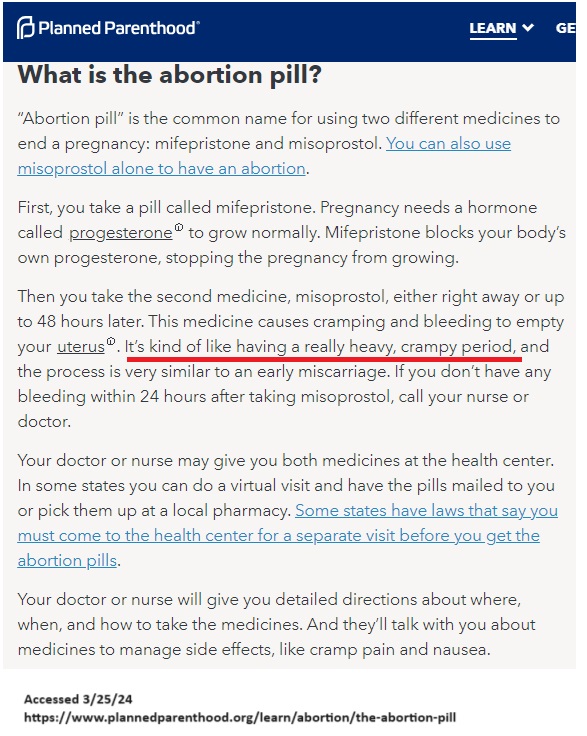
Planned Parenthood described abortion pill as heavy period
Abortion chain Carafem tells their paying clients that,
Most people start to see cramping and bleeding within about an hour after taking the misoprostol, though some take longer. It’s normal to feel chills, nausea or even have diarrhea along with bleeding and cramping while your body is pushing the pregnancy from your uterus.
It’s kind of like having a really heavy, crampy period along with mild flu-like symptoms. It is good to have some thick overnite type maxi pads ready along with a heating pad to help with cramping. carafem provides anti-nausea and pain medication to help handle these symptoms.
For most people, the heaviest bleeding and cramping ends once the pregnancy has passed, usually within 3-4 hours.
According to Salon, even though many abortion facilities offer pain medications, “the patient might be seeking out additional options for pain management as passing the fetal tissue can be quite painful.”
“We give ibuprofen and use heat and ways to manage that pain, but both bleeding and pain should decrease” once the tissue has passed, Cadwallader told Salon. “We tell folks if you’re soaking through a maxi pad, two, in an hour to two hours, they should seek help.”
Seek help from where?
Cadwallader doesn’t say, despite the REMS requirement that the prescriber be able to offer assistance or refer women for help where needed.
Still, one observational study conducted at two centers in Bologna, Italy, found that 40% of women experienced severe pain when undergoing chemical (abortion pill) abortions. And Live Action’s I Saw My Baby website details the horrific fallout when women see their own aborted children floating in the toilet after taking the drugs at home.
Serena Dyksen, founder of the post-abortive ministry She Found His Grace, knows this all too well. She operates the I Regret My Abortion Facebook group, and she told Live Action News that women often tell the group that abortion providers offered little information about what to expect when taking the abortion pill.
“Here’s what I can say about the abortion pill: we have women that text us, and we’ve seen it in other places too [i.e., the regret groups], women say that they were lied to. They thought that it wasn’t going to be a big deal. And they are traumatized on a new level, because now they are seeing their babies. They’re told just to flush them. It has affected their mental health in a whole new way that I don’t think people are really prepared for.”
Reason #3: Inaccurate pregnancy tests
When was the last time you heard of anyone presenting to the emergency room because a pregnancy test was not accurate? Yet that is what Salon claims is a reason women visit ERs after taking abortion pills.
“Frequently, Upadhyay said, medication abortion patients will actually go to the emergency department to seek clinical care and make sure that the medication worked. That’s because a pregnancy test won’t be accurate for at least four to five weeks after a medication abortion, because the pregnancy hormones need time to leave the person’s system,” Salon wrote.
But the fact is, as AHM claimed in its brief before the Supreme Court, that the FDA’s medication guide acknowledges that as many as seven percent (7%) of women will need surgery after taking mifepristone “to stop bleeding” or to complete the abortion.
In 2023 alone, that would potentially be between 13,000 and 45,000 women.
Still, the question remains, why would women seek care at emergency rooms to confirm the abortion was complete instead of going back the provider who sold them the abortion? And who is being invoiced for this care?
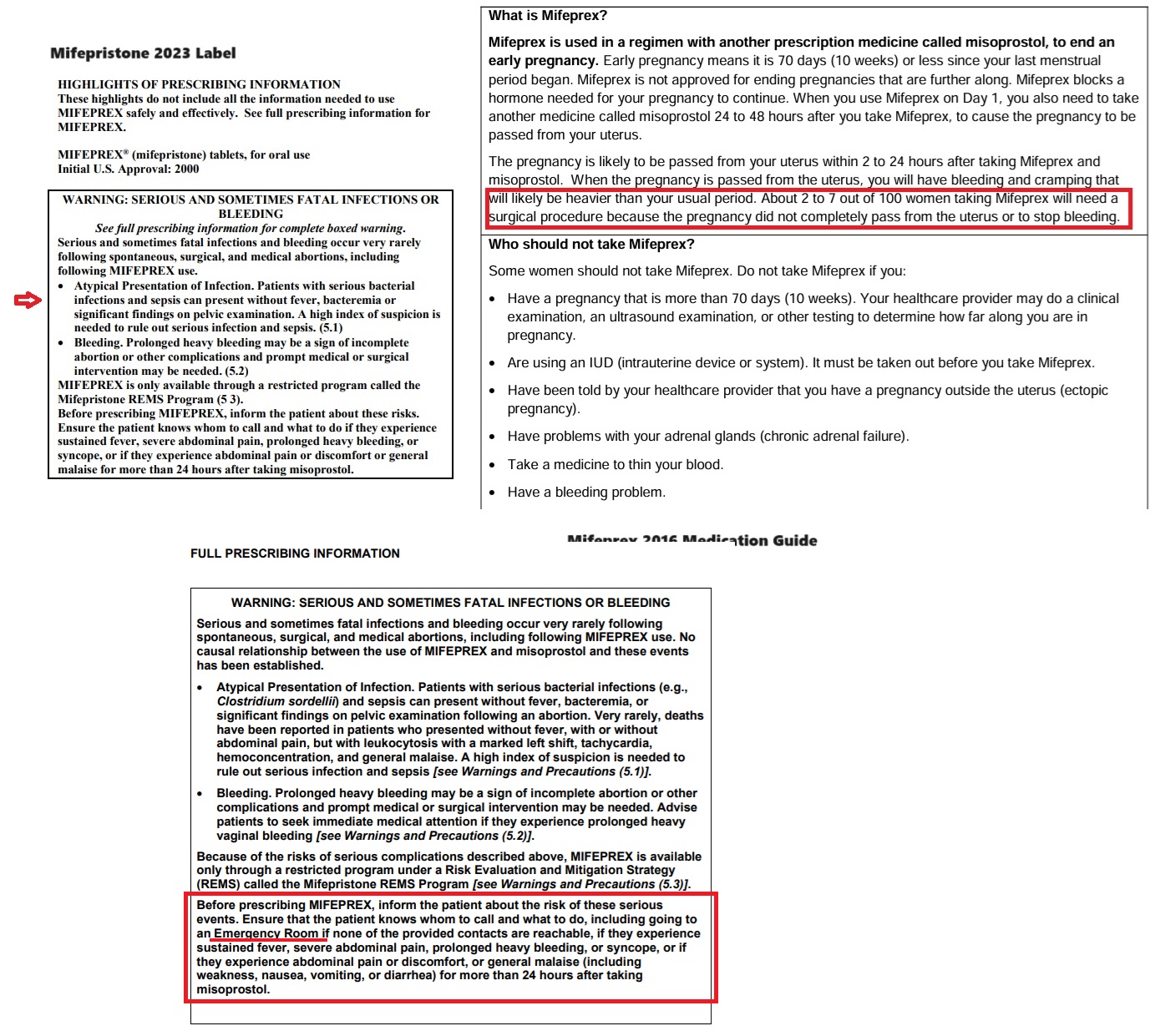
Abortion pill Black Box warning and medication guide suggests sending women to ER
Abortion consent forms previously reviewed by Live Action News indicated that when a patient needs emergency medical care which cannot be provided on site, the patient is responsible for paying for it.
Reason #4: To “ask questions”
In a separate PBS NewsHour report, Upadhyay admitted that a “small percentage” of abortion pill clients visit the emergency room but “mostly to make sure their symptoms are normal.”
PBS also interviewed Linda Prine, an Aid Access provider and co-founder of the Miscarriage and Abortion Hotline who claimed women who take the abortion pill are often “freaked out” by what they see.
“What’s important to know is that a visit to an emergency room is not the same as a serious adverse event,” Upadhyay claimed.
But what Upadhyay failed to point out is that, due to Big Abortion’s influence, there are zero requirements to report any abortion pill adverse events. And as Live Action News previously documented, Big Abortion encourages women and doctors to conceal abortion pill complications.
“People go to the emergency room to get care and to ask questions and to get clinical support,” Upadhyay suggested.
Interestingly, the PBS NewsHour interviews were conducted by Sarah Varney, a health reporter for KFFHealthNews.org, described as “one of the three major operating programs at KFF.” KFF, otherwise known as The Kaiser Family Foundation or The Henry J. Kaiser Family Foundation, has on its website a list of its supporters. Many are abortion philanthropists, including the Bill and Melinda Gates Foundation, the Ford Foundation, and the Susan Thompson Buffett Foundation – all known for also funding Big Abortion.
KFF has been named a past recipient of Planned Parenthood’s infamous PPFA Maggie Award (named after eugenicist founder Margaret Sanger), and according to some reports, the Kaiser Family Foundation was described as one of the original investors in the abortion pill, RU-486, when it was first introduced to the U.S. through the Population Council. Kaiser has also sponsored studies on multiple uses of the abortion pill.
The U.S. Supreme Court will hear arguments Tuesday over whether to restrict access to mifepristone, one of two drugs used in medication abortions.@SarahVarney4 reports on what's at stake. pic.twitter.com/i8orF961U4
— PBS News (@NewsHour) March 25, 2024
What Are the Facts?
Complications involving visits to emergency rooms after abortion pills are not “junk science” based on “anti-abortion” rhetoric, as Salon suggested.
As AHM claimed in its brief, abortion pill-related emergency room visits are estimated to be in the tens of thousands, affecting “roughly one in 25 women” who take the drug.
The data is based on published percentages for ER visits listed on the drug’s 2023 label. This label states that 2.9 to 4.6 percent of women who take abortion drugs end up in the emergency room.
In 2023 alone, this would be potentially between about 19,000 (18,638) and 30,000 (29,564) women.
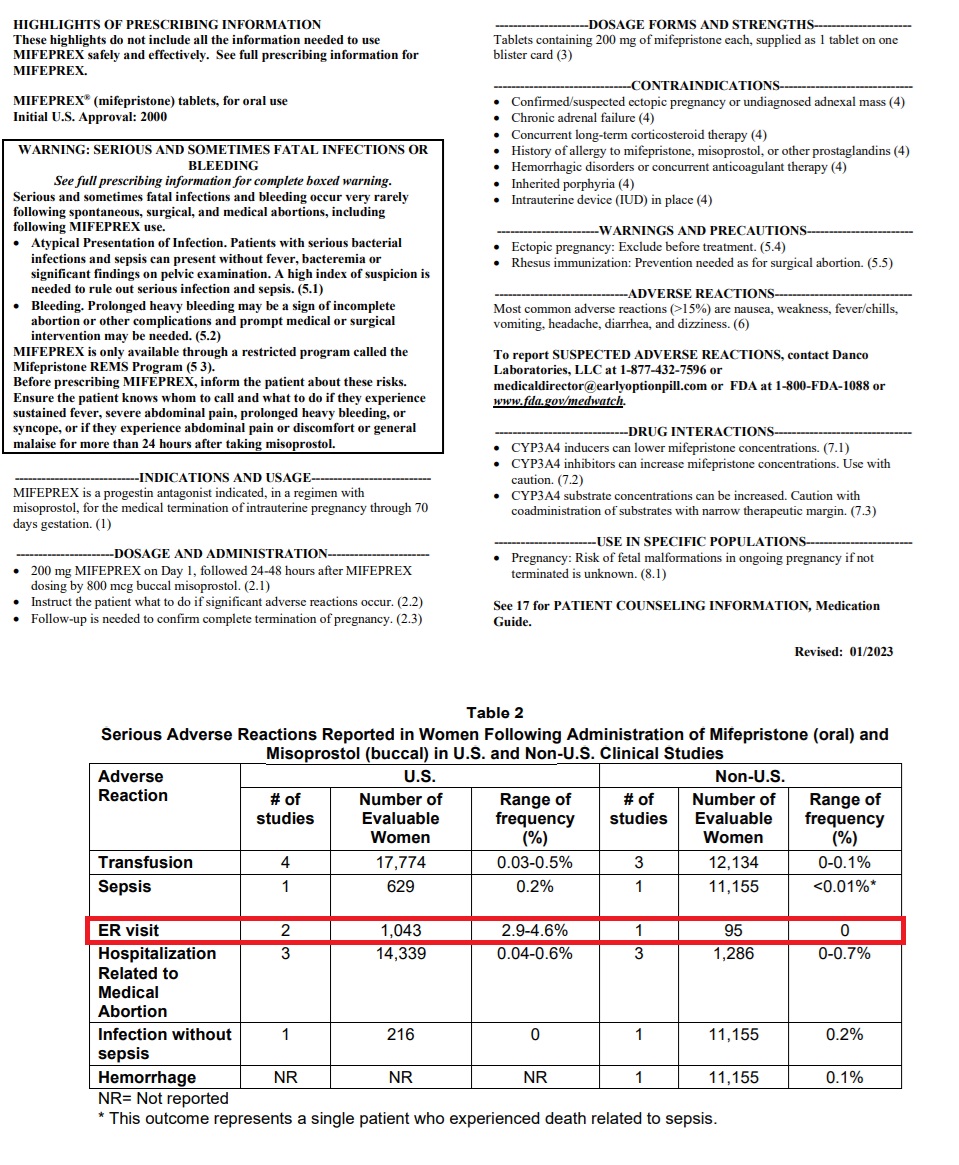
Mifepristone Jan 2023 label shows percentage of women taking abortion pill visit ER
The data is also similar to findings from a previously documented Gynuity Health Projects (GHP) telabortion study which found that six percent (6%) of participants (70 out of 1,157) faced complications from the abortion pill which resulted in ER visits or urgent care visits. Gynuity is a pro-abortion group, conducting clinical trials on the abortion pill and is funded by organizations with deep historic ties to the American eugenics movement.
Additional studies showed a similar pattern.
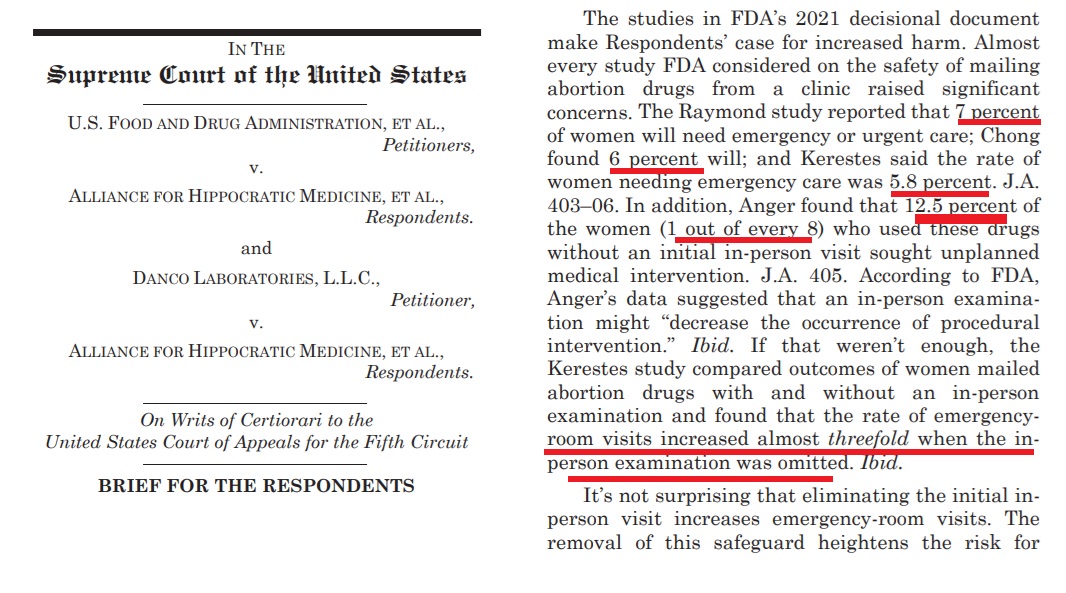
AHM lawsuit studies for 2021 REMS shows high amounts of abortion pill clients visit ER (AHM v FDA) brief filed by AHM 022224
Big Abortion: Emergency Room Staff Should Lie
While Big Abortion admits abortion pill clients are presenting to emergency rooms, the media has failed to expose potential cover-ups of abortion pill complications.
In a video report published by Vice News, New Mexico abortionist Franz Theard can be heard advising an abortion pill client to lie if she has a complication. “If you have to go to the hospital for any reason, you don’t have to admit that you had the abortion pill; you can say ‘I’m having a miscarriage,’” Theard was heard stating.
While it is one thing to suggest that abortion clients lie, a separate ANSIRH abortion doctor by the name of Daniel Grossman previously suggested that medical personnel at emergency rooms should falsify documents to cover up abortion pill complications. This unethical cover-up would likely diminish any chance that accurate numbers on abortion pill complications/deaths would be reported to authorities.
Stunningly, that dangerous suggestion was also published by Salon.







